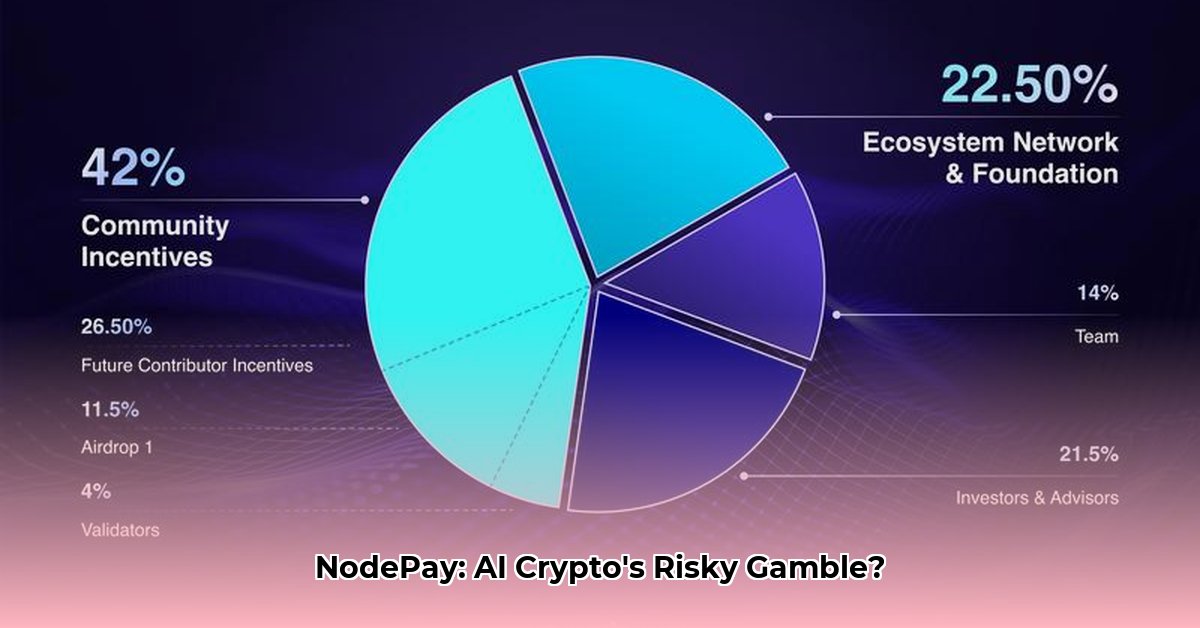
Nodepay Price: Decoding the Ups and Downs of AI Crypto
Nodepay (NC) is a cryptocurrency uniquely positioned at the intersection of digital currency and artificial intelligence (AI) development. Users contribute their idle computing power to train AI models, earning NC as compensation. While this innovative approach holds significant promise, understanding the volatility of its price is crucial. The price of NC has demonstrated considerable fluctuation, with daily swings exceeding 10% at times. This inherent volatility underscores the high-risk, high-reward nature of investing in Nodepay. Recall the all-time high of $0.327; while a significant achievement, it’s important to consider the current market context.
Navigating Data Challenges and Market Cap Uncertainty
Accurately assessing the true Nodepay price presents challenges. Discrepancies exist across different reporting platforms (such as CoinMarketCap) regarding daily trading volume and other key metrics. The relative youth of the cryptocurrency market contributes to these inconsistencies, making comprehensive analysis difficult. Furthermore, the lack of readily available information on Nodepay's total market capitalization hinders a complete valuation assessment. A smaller market cap often implies lower liquidity, increasing susceptibility to price manipulation and volatile swings—a factor to consider for smaller crypto projects like Nodepay. This lack of transparency necessitates a cautious approach. Is this lack of transparency a deterrent for potential investors?
Technological Innovation and Inherent Uncertainties
Nodepay's innovative core concept—leveraging unused computing power for AI training—is undeniably groundbreaking. Imagine a global network of computers collaboratively powering next-generation AI. However, crucial questions remain regarding the scalability of this system for training large AI models and its resilience against cyberattacks. These unresolved questions represent considerable uncertainties that could significantly impact Nodepay's future and, subsequently, its price. How will Nodepay address these scalability and security concerns?
Regulatory Landscape and Compliance
The evolving regulatory environment poses another significant challenge. Governments are increasingly scrutinizing AI development, focusing on data privacy and security. Nodepay's decentralized structure might face compliance challenges. Will it successfully adapt to this complex regulatory landscape? Successful navigation of this landscape is crucial for Nodepay's long-term success. What compliance strategies is Nodepay employing to navigate this complex regulatory environment?
Actionable Insights for Key Stakeholders
A strategic approach to Nodepay requires a nuanced understanding, varying depending on the stakeholder group:
| Stakeholder Group | Short-Term Considerations | Long-Term Considerations |
|---|---|---|
| Nodepay Developers | Improve data transparency, enhance platform security. | Focus on scalability, build strong partnerships, navigate regulatory changes. |
| Investors | Diversify investments, closely monitor price trends, risk assessment. | Assess technological advancements, understand regulatory implications, long term outlook. |
| Users (Contributing Power) | Evaluate platform security and user experience, privacy considerations. | Track network stability, analyze long-term profitability, potential returns. |
| AI Companies | Compare Nodepay's cost and performance against traditional methods. | Assess long-term scalability and reliability for their AI developments. |
Risk Assessment Matrix: Navigating the Uncertainties
Investing in Nodepay involves substantial risk. A comprehensive risk assessment is vital:
| Factor | Risk Level | Mitigation Strategies |
|---|---|---|
| Price Volatility | High | Diversify investments, adopt a long-term perspective. |
| Regulatory Uncertainty | Medium | Stay updated on regulatory developments, seek expert advice. |
| Security Vulnerabilities | Medium | Regularly monitor security updates and independent audits. |
| Scalability Challenges | Medium | Evaluate progress on infrastructure improvements and announcements. |
| Market Adoption | High | Track user growth and overall platform performance. |
Disclaimer: This analysis is for informational purposes and does not constitute financial advice. Cryptocurrency investments are inherently risky. Thorough research is crucial before any investment decision.
Mitigating Regulatory Risks for Nodepay's Decentralized AI Cryptocurrency
Nodepay's decentralized AI infrastructure presents both remarkable potential and considerable regulatory challenges. Its reliance on user-contributed data necessitates careful attention to privacy regulations like GDPR and CCPA. Effective risk mitigation requires a multi-faceted approach.
Proactive Strategies for Regulatory Compliance
1. Robust Legal Framework: A dedicated legal team specializing in data privacy and blockchain regulations is essential to ensure full compliance. Key actions include establishing clear data privacy policies, implementing robust data security, conducting regular compliance audits, and seeking regional legal counsel.
2. Transparency and Data Handling: Open communication regarding the collection, usage, and protection of user data builds trust and accountability. This is vital for fostering positive relationships with regulators and users alike.
3. Proactive Regulatory Engagement: Collaborative engagement with regulatory bodies, rather than adversarial stances, helps shape supportive frameworks while safeguarding user rights.
4. Community Building and Engagement: An informed and engaged user community acts as a powerful advocate. Transparency about regulatory developments and proactive risk management builds trust and fosters community support.
5. Technological Safeguards: Implementing technologies like anonymization, differential privacy, and secure data storage minimizes data-related risks.
Long-Term Viability: Continuous Adaptation
Successfully mitigating regulatory risks for Nodepay isn't a short-term project; it’s an ongoing process. The regulatory landscape continuously evolves, requiring constant vigilance and adaptation. Proactive risk management is not merely about legal compliance; it’s about building trust, strengthening the community, and securing the long-term success of the Nodepay ecosystem. The long-term viability of Nodepay depends critically on its ability to proactively address these challenges.